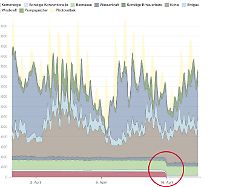Energy supply without nuclear power
How Germany currently generates electricity
By Martin Morcinek and Laura Stresing
4/20/2023 1:53 p.m
The last German nuclear power plants are off the grid: since mid-April, the German energy supply has had to do without nuclear power. Which energy sources will fill the resulting gap? A look at the daily updated data from the Federal Network Agency.
The use of nuclear energy to generate electricity in Germany is history. On the evening of April 15, 2023, technicians disconnected the Isar 2, Emsland and Neckarwestheim 2 nuclear power plants. After 63 years, the proportion of nuclear power in the German energy grid fell to zero. The other energy sources – including above all coal, wind power, oil, natural gas, solar and biomass – have to step in to completely cover Germany’s electricity needs.
How the electricity mix in Germany has changed as a result of the historic phase-out of nuclear power can be observed using daily data from the Federal Network Agency:
The official numbers show the electricity production actually fed into the grid by days. The breakdown according to hours of the day provides insights into the performance contribution of strongly fluctuating energy sources such as wind strength and solar radiation. In order to supplement the yields from wind and solar power plants, which are difficult to plan, fossil-fired power plants in particular are currently stepping in.
The energy suppliers cover increased electricity requirements in the morning and evening hours primarily with the help of pumped storage power plants. At the push of a button, the energy stored there can be directed from reservoirs to the turbines of the generators. The storage technology helps to serve short-term peaks in demand. So far, the shutdown of the last German nuclear power plants has not led to any problems or to the power outages that were sometimes feared.
In any case, the gap left by the phase-out of nuclear energy in Germany is not large. Most recently, the last three nuclear power plants only fed around 2700 megawatts per hour into the German power grid. This is significantly less than the German energy producers alone could contribute with their biomass power plants, which are also capable of providing base loads.
Experts do not see any major difficulties arising from the shutdown of the nuclear power plant for the coming winter, when seasonal dark doldrums threaten. “Technically and economically, even a large economy like Germany can be supplied with electricity exclusively from renewable sources,” said electricity market observer Fabian Huneke in an interview. “It just hasn’t been resolved on the regulatory side, and it hasn’t yet been resolved in terms of social acceptance.”
